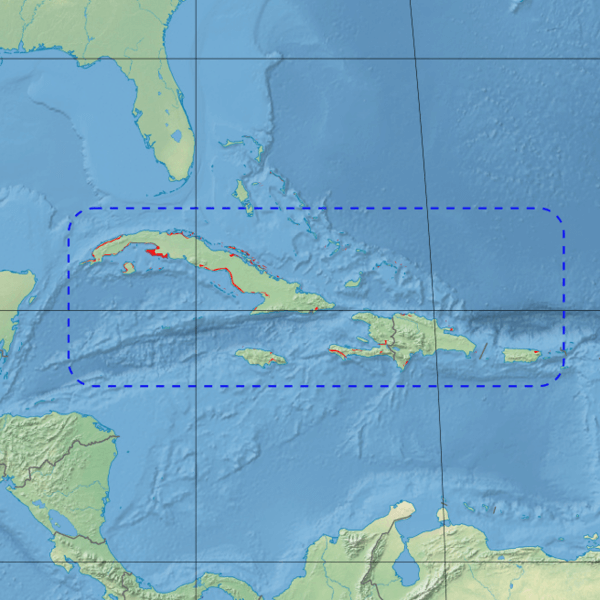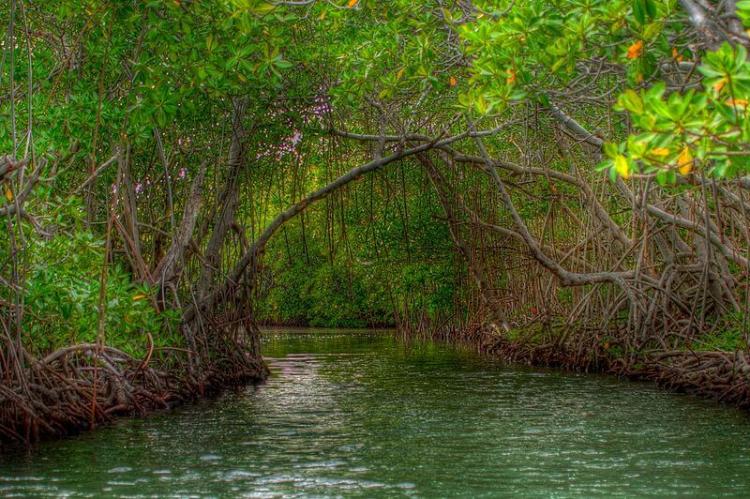Guardians of the Caribbean: The Greater Antilles Mangroves Ecoregion
The Greater Antilles Mangroves ecoregion is essential for coastal ecosystems, supporting rich biodiversity and creating a protective barrier between land and ocean. Thriving from Cuba and Hispaniola to Puerto Rico and Jamaica, these mangrove forests offer shelter to countless species in the Caribbean.
Nature's Coastal Sentinels: The Greater Antilles Mangroves
Spanning the coasts of some of the most iconic islands in the Caribbean Sea, the Greater Antilles Mangroves ecoregion forms a vital natural network that supports a rich array of biodiversity and plays a critical role in the health of coastal ecosystems. From the shores of Cuba and Hispaniola to Puerto Rico and Jamaica, these mangrove forests thrive in the warm, shallow waters of the Caribbean Sea, creating a buffer between land and ocean while providing shelter to countless species. Their ecological, economic, and cultural significance makes them indispensable to the region's well-being and to the livelihoods of the people who call the Greater Antilles home. The mangroves protect coastal areas from erosion and storm surges, serve as nurseries for marine life, and provide habitats for birds, reptiles, and other wildlife. Despite their importance, these ecosystems face numerous threats, including deforestation, pollution, and climate change. Understanding the intricate dynamics of the Greater Antilles Mangroves is crucial for their conservation and protection and the many benefits they provide.
Geographic Distribution and Characteristics
The Greater Antilles Mangroves ecoregion is spread across the main islands of the Greater Antilles: Cuba, Hispaniola (which includes Haiti and the Dominican Republic), Jamaica, and Puerto Rico. These mangrove forests are generally found in coastal areas, particularly river deltas, estuaries, and shallow lagoons where saltwater meets freshwater. Mangroves thrive in these brackish water conditions, with their specialized root systems that allow them to tolerate high salt concentrations and low oxygen levels.
There are four main species of mangroves in this ecoregion: the red mangrove (Rhizophora mangle), black mangrove (Avicennia germinans), white mangrove (Laguncularia racemosa), and buttonwood mangrove (Conocarpus erectus). Each species occupies a specific zone based on its tolerance to salinity and inundation. Red mangroves, with their iconic prop roots, are typically found closest to the water's edge, where they stabilize coastlines and reduce erosion. Black mangroves, characterized by their pneumatophores (aerial roots), are found slightly further inland, while white mangroves and buttonwoods occupy the highest elevations within the tidal zone.
Biodiversity and Ecological Importance
The Greater Antilles Mangroves are among the most productive ecosystems on Earth, supporting a diverse array of flora and fauna. These mangrove forests provide essential habitat and breeding grounds for many species of fish, crustaceans, and mollusks, which in turn support larger predators and contribute to the overall health of the marine food web. Species such as the Nassau grouper (Epinephelus striatus) and various snapper species depend on mangrove habitats during their juvenile stages.
Mangroves also offer vital nesting and feeding sites for numerous bird species, including the West Indian whistling duck (Dendrocygna arborea), brown pelican (Pelecanus occidentalis), and the endangered Puerto Rican parrot (Amazona vittata). Reptiles like the American crocodile (Crocodylus acutus) and various iguana species find refuge within these tangled roots. Additionally, mangrove ecosystems support endemic plant species that are specially adapted to the saline and waterlogged conditions of the coastal environment.
Beyond supporting wildlife, mangroves are crucial in protecting coastal areas from storm surges and hurricanes, which are common in the Caribbean. Their dense root systems absorb wave energy, reduce erosion, and trap sediments, stabilizing coastlines. This natural barrier protects human settlements and prevents saltwater intrusion into freshwater aquifers, ensuring the availability of fresh water for local communities.
Economic and Cultural Significance
The Greater Antilles Mangroves hold significant economic value for the local communities. They support fisheries by providing breeding and nursery grounds for commercially important fish and shellfish species. These fisheries are a major source of food and income for coastal populations, contributing to the local economy and food security. Healthy mangrove ecosystems also support tourism, as the scenic coastal landscapes and rich biodiversity attract visitors for activities such as birdwatching, kayaking, and snorkeling.
Culturally, mangroves have been intertwined with the lives of the Caribbean people for centuries. They are sources of traditional medicines, building materials, and firewood. Many Indigenous and local communities have deep-rooted connections with mangrove ecosystems, relying on them for subsistence and cultural practices. The knowledge of sustainable mangrove use and management passed down through generations is invaluable for contemporary conservation efforts.
Threats to the Greater Antilles Mangroves
Despite their ecological and economic importance, the mangrove ecosystems of the Greater Antilles face numerous threats. Coastal development, including expanding urban areas, tourism infrastructure, and agriculture, often leads to deforestation and habitat loss. The conversion of mangrove areas into shrimp farms and salt pans further reduces available habitat for wildlife and disrupts the ecological balance.
Pollution from agricultural runoff, sewage discharge, and oil spills poses significant risks to mangrove health. Nutrient-rich runoff can lead to algal blooms and hypoxia, negatively affecting water quality and the organisms that depend on these habitats. Additionally, the introduction of invasive species can disrupt the delicate ecological interactions within mangrove ecosystems.
Climate change represents a growing threat to the Greater Antilles Mangroves. Rising sea levels, increased storm frequency, and changes in precipitation patterns can alter the salinity and inundation levels that mangroves rely on. Prolonged flooding or drought conditions can stress mangrove trees, making them more susceptible to disease and reducing their ability to provide ecosystem services.
Conservation Efforts and Future Prospects
Efforts to conserve the Greater Antilles Mangroves have gained momentum in recent years, recognizing their crucial role in biodiversity preservation and climate resilience. Protected areas have been established in many regions, such as the Ciénaga de Zapata in Cuba and the Laguna de Oviedo in the Dominican Republic, to safeguard critical mangrove habitats. National and regional conservation programs focus on habitat restoration, sustainable management practices, and community involvement in conservation initiatives.
Education and awareness campaigns are key in promoting the value of mangroves and the need for their protection. By involving local communities and stakeholders, these initiatives foster a sense of stewardship and encourage sustainable practices that benefit both the environment and livelihoods. International cooperation and funding from organizations such as UNESCO, The Nature Conservancy, and the Caribbean Biodiversity Fund further support conservation efforts in the Greater Antilles.
Restoration projects aim to rehabilitate degraded mangrove areas, often involving replanting native mangrove species and removing invasive plants. These efforts help enhance the resilience of coastal ecosystems, improve water quality, and provide long-term benefits for biodiversity and human communities.
Conclusion
The Greater Antilles Mangroves ecoregion is a natural treasure that plays a critical role in the health and resilience of Caribbean coastal ecosystems. These mangrove forests support diverse wildlife, protect coastlines from erosion and storm damage, and provide economic and cultural benefits to local communities. Despite facing threats from human activities and climate change, ongoing conservation efforts offer hope for the future of these vital ecosystems. By prioritizing the protection and restoration of mangroves, the Greater Antilles can ensure the preservation of this invaluable natural heritage for generations to come.

Map depicting the location of the Greater Antilles mangroves (red areas in blue-hashed box).
